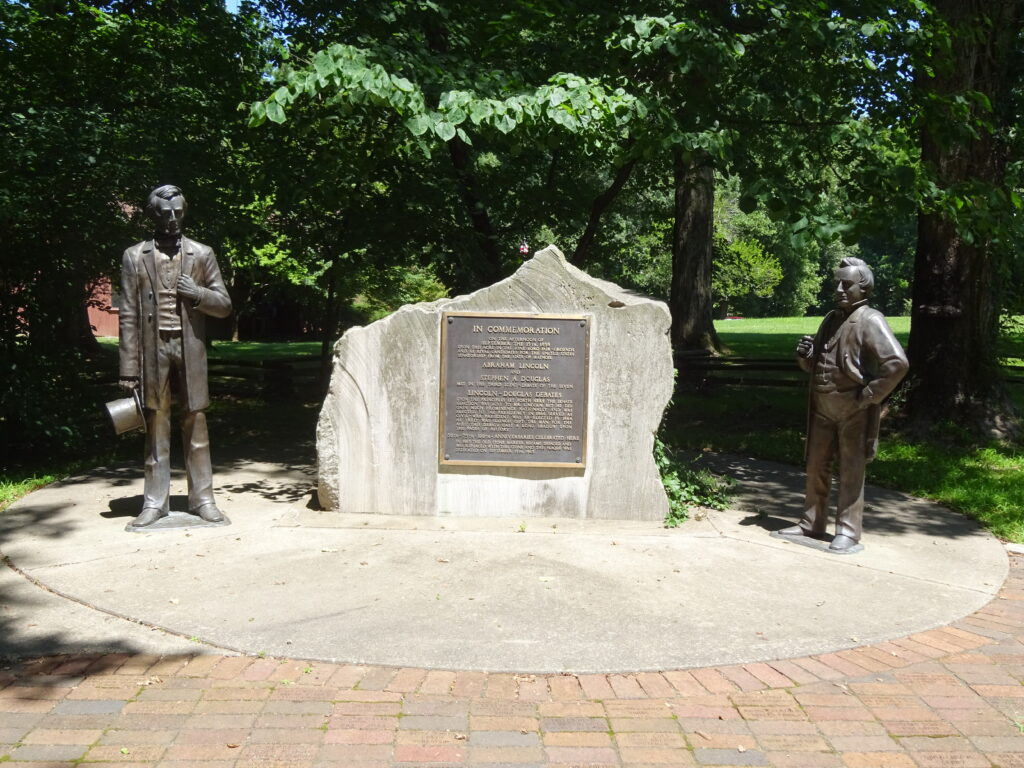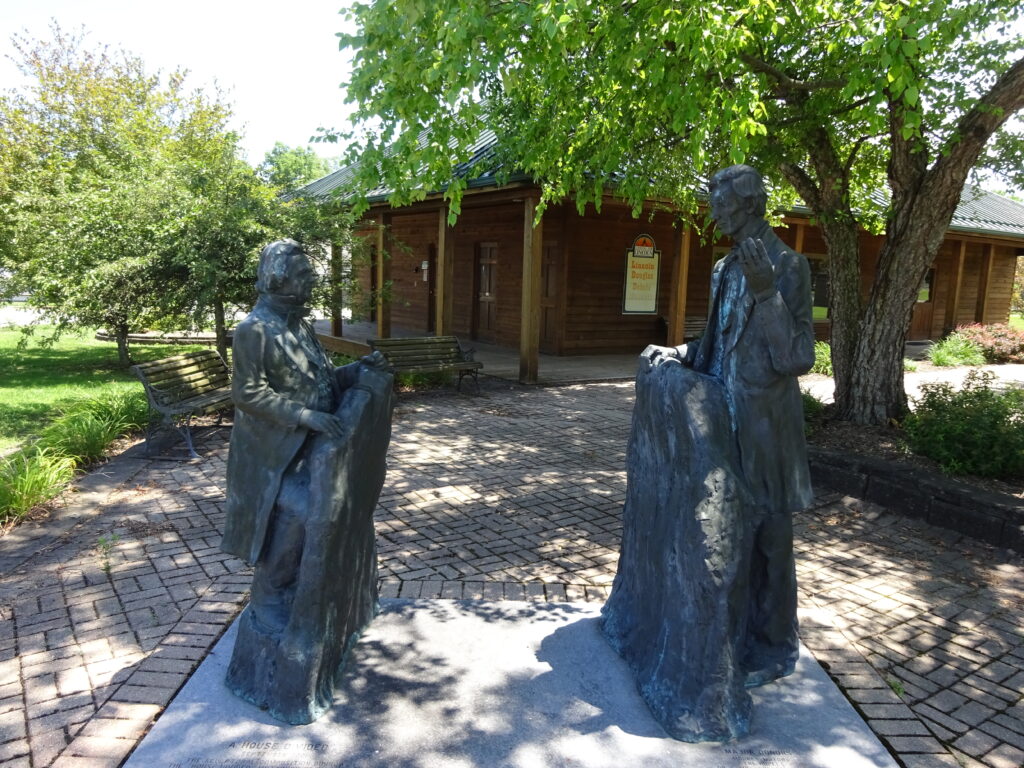After haggling out the arrangements and debates in Ottawa and Freeport in the northern part of Illinois, Abraham Lincoln and Stephen A. Douglas slowly made their way down to the southern part of the state for two debates in quick succession. Along the way they each gave a myriad of additional individual speeches to smaller venues.
Jonesboro, September 15, 1858
The third official Lincoln-Douglas debate was held in Jonesboro, which was as far south as Freeport had been north. They reflected two vastly different citizenries. Whereas the northern part of Illinois had largely been settled by northeasterners moving west, the southern part of the state was mostly settled by slave state migrants moving north. Unlike Freeport, the sparsely populated Jonesboro (about 1,500 residents) was heavily supportive of the Democratic party views on slavery (i.e., proslavery or pro-accommodating to southern rights to enslave other Americans based on the color of their skin). It’s safe to say that Lincoln was at a disadvantage.
Douglas was well aware of this. He charged Lincoln and the Republicans (which by now Democrats had started to refer to as “Black Republicans”) said one thing in northern Illinois, something different in central Illinois, and something wholly different in the southern part of Illinois. Douglas argued that Lincoln wanted full racial equality, a position that was anathema across Illinois in general and perhaps fatal in the deepest south portions of the state like Jonesboro. Lincoln not only denied he pitched differently in the north and south, but also went on offense to quote documents and speeches by Democrats to demonstrate that it was they, the self-avowed conservative Democrats who had entirely different stories across the state.
Lincoln’s main focus in Jonesboro was to argue that the expansion of slavery into the western territories would endanger the rest of the Union. He pointed out this was already happening as he looked back over the fight over slavery in Missouri, the upheaval over whether slavery could go into the territories taken after the Mexican War, and the resulting “Bleeding Kansas” violence. The only way past the crisis, he said, would be to put slavery on “the course of ultimate extinction.”

Charleston, September 18,1858
Three days later the two men found themselves about 175 miles northeast in Charleston, where they would begin a wide counterclockwise swing through the remaining four debate sites. Charleston had many southern migrants from slave states but even the more antislavery residents were not in favor of equal political or social rights for African Americans. It was one thing to find slavery abhorrent, yet another to call for full equality. Douglas used this sentiment to his benefit by running a clearly racist campaign overall. In Jonesboro he had accused Lincoln of favoring racial equality. To emphasize Douglas’s constant fearmongering of amalgamation, or worse, his supporters held up a banner that read “Negro equality” with a picture of a white man, a negro woman, and a mulatto child. His goal was to either get Lincoln to declare he was for full equality or to declare he wasn’t for full equality. Admitting the former would have ended Lincoln’s campaign immediately in a time when racism was the norm, even among most abolitionists.
Painted into a corner, Lincoln chose to open the debate by saying that while he was entirely against slavery, he was not “in favor of bringing about in any way the social and political equality of the white and black races.” He further added that he thought “there a physical difference” that would “forever forbid the two races living together on terms of social and political equality. And inasmuch as they cannot so lie, while they do remain together there must be the position of superior and inferior, and I as much as any other man am in favor of having the superior position assigned to the white race.”
That particular passage and similar statements in the other debates continues to be analyzed to this day. Those so inclined to find fault with Lincoln see him as a typical racist. Those more understanding see it as a political hedging to avoid being booed off the platform, or worse, dragged through the streets and perhaps killed. Those more thoughtful analysts see Lincoln as a less racist man of his racist times struggling to maintain political viability to continue the opportunity of ending slavery.
Lincoln had some charges of his own. He accused Douglas of conspiring with Chief Justice Roger Taney, former President Franklin Pierce, and current President James Buchanan to enable the creation of a pro-slavery constitution for Kansas without allowing the actual residents of Kansas to express their views and vote on it. Not surprisingly, Douglas denied it. Douglas did declare that the government should exist as he believed the founders intended, with some states slave and others free.*
These two debates offered distinct contrasts in other ways as well. Jonesboro had the smallest attendance with perhaps 1,500 people present. Charleston had around 12,000 in attendance, including eleven railroad cars of people who traveled from Indiana to hear these two men speak on the most contentious issue of the day.

As with all the other of the seven debate sites, statues of Lincoln and Douglas have been erected. In Jonesboro, full-size bronzes of the two men stand on either side of a large limestone boulder carrying a bronze plaque. A “Looking for Lincoln” wayside marker explains the debate. The Charleston site also boasts full-size bronze sculptures, this time with the two men facing each other over rock-like “podiums.” Charleston is also the only site with a Debate Museum on the grounds, where visitors can pose for photos and watch a film that tells the story of the debate.
After Charleston, the next official debate would not occur for almost three weeks in Galesburg, where Lincoln would “go through college” for the very first time.
[Photos of Jonesboro (top) and Charleston (bottom) by David J. Kent.]

Lincoln: The Fire of Genius: How Abraham Lincoln’s Commitment to Science and Technology Helped Modernize America is available at booksellers nationwide.
Limited signed copies are available via this website. The book also listed on Goodreads, the database where I keep track of my reading. Click on the “Want to Read” button to put it on your reading list. Please leave a review on Goodreads and Amazon if you like the book.
You also follow my author page on Facebook.
David J. Kent is Immediate Past President of the Lincoln Group of DC and the author of Lincoln: The Fire of Genius: How Abraham Lincoln’s Commitment to Science and Technology Helped Modernize America and Lincoln: The Man Who Saved America.
His previous books include Tesla: The Wizard of Electricity andEdison: The Inventor of the Modern World and two specialty e-books: Nikola Tesla: Renewable Energy Ahead of Its Time and Abraham Lincoln and Nikola Tesla: Connected by Fate.










